Extensor hallucis longus: Anatomy, Origin, Insertion, Function, exercise
Table of Contents
Introduction
- The Extensor hallucis longus is a thin muscle, situated between the Tibialis anterior & the Extensor Digitorum Longus in the anterior compartment of the lower leg. It provides the only active extension force to the interphalangeal joint & the primary active extension force to the metatarsophalangeal joint. It has a smaller moment arm for dorsiflexion at the ankle than the anterior tibialis muscle. It has a smaller physiological cross-sectional part than either the anterior tibialis & the extensor digitorum longus.
Origin of Extensor hallucis longus
- From the middle 2 quarters of the anterior part of the fibula & the adjacent interosseous membrane.
Insertion
- Extensor hallucis longus passes deep into the extensor retinaculum before inserting at the base of the distal phalanx of the big toe.
Structure
- The extensor hallucis longus muscle arises from the anterior surface of the fibula for about the middle 2/4th of its extent, medial to the origin of the extensor digitorum longus muscle. It also attaches from the interosseous membrane of the leg to a similar extent.
- The anterior tibial vessels & deep fibular nerve lie between it & the tibialis anterior.
- The fibers pass downward, & end in a tendon, which occupies the anterior border of the muscle, passes through a distinct compartment in the cruciate crural ligament, crosses from the lateral to the medial side of the anterior tibial vessels near the bend of the ankle, & is inserted into the base of the distal phalanx of the great toe.
- opposite the metatarsophalangeal articulation, the tendon gives off a thin prolongation on either side, to cover the part of the joint.
- An expansion from the medial portion of the tendon is generally inserted into the base of the proximal phalanx.
Function of Extensor hallucis longus
- The main function of the extensor hallucis longus muscle is the extension of the big toe (hallux). This action happens in both metatarsophalangeal & interphalangeal joints of the hallux. This extension is a crucial movement in walking & running.
- Working together with other muscles from the anterior compartment of the leg, the extensor hallucis longus muscle dorsiflexes the foot in the ankle joint. When the foot is fixed on the ground(e.g. walking & doing squats) the muscle pulls the body slightly forward & prevents losing gravity & falling backward.
Relations
- The Extensor hallucis longus is situated between 2 muscles, posterolaterally to the tibialis anterior & posteromedially to the extensor digitorum longus muscle. The anterior tibial artery & vein & deep peroneal nerve run between the extensor hallucis longus & the tibialis anterior muscles
- The tendon of the extensor hallucis longus muscle in the dorsum of the foot runs medially to the tendon of the extensor digitorum longus. Between those 2 tendons, the dorsalis pedis artery pulse can be easily palpated.
- When extensor hallucis extends the big toe, the tendon of the muscle can be seen on the dorsal aspect of the big toe, laterally to the tendon of the tibialis anterior muscle. The space between these 2 tendons is an important clinical location; it serves as an entry point for injections or aspiration procedures in the ankle joint.
Blood supply
- The blood supply for the extensor hallucis longus muscle mainly comes from the anterior tibial artery & its branches. In further, the muscle can be supplied by the branches of the fibular artery.
- The venous blood from this part is mainly drained by the anterior tibial vein which empties into the popliteal vein.
Nerve Supply
- Deep peroneal nerve L4, L5.
variations
- Sometimes united at its origin with the extensor digitorum longus.
- The extensor ossis metatarsi hallucis, a small muscle, is many times found as a slip from the extensor hallucis longus, from the tibialis anterior, or from the extensor digitorum longus, or as a distinct muscle; it traverses the same parts of the transverse ligament with the extensor hallucis longus.
Clinical importance
Paralysis of Extensor hallucis longus
- In the paralysis of Extensor hallucis longus, the action of Extensor hallucis brevis is dominant, the distal phalanx does not extend & the proximal phalanx extends in the direction of adduction.
Effect of Weakness
- Weakness of Extensor hallucis longus decreases extension at the metatarsophalangeal & interphalangeal joints. As it is the only muscle for the extension of the interphalangeal joint, decreased dorsiflexion of the great toe is diagnostic for Extensor hallucis longus weakness.
- During normal locomotion, an individual contacts the floor with the heel of the foot 1st. The ground reaction force put in a plantarflexion moment to the foot, which is resisted by all of the dorsiflexors functions. Weakness of the Extensor hallucis longus diminishes an individual’s ability to control the descent of the medial part of the foot, particularly the great toe.
- Patients with weakness of the extensor hallucis longus also report that the toe tends to fold under the front when they are pulling on socks or shoes &can cause tripping.
Effect of Tightness
- Tightness of the Extensor hallucis longus pulls the metatarsophalangeal joint of the great toe into extension, which, as in the fingers & thumb, tends to produce flexion at the interphalangeal joint, leading to a claw toe deformity.
- Hyperextension of the great toe pulls the plantar plate distally, exposing the metatarsal head to excessive loads & producing pain. Similarly, hyperextension of the metatarsophalangeal joint pulls the interphalangeal joint into the toe box of a shoe, causing pain & calluses, or corns, on the dorsal surface of the interphalangeal joint.
Claw Deformities of the toes :
- Claw toe deformities in a foot with sensation are fully painful. Claw deformities in a foot without sensation put the individual at risk of skin breakdown as the result of increased pressure under the metatarsal heads & between the dorsal surfaces of the toes & the shoe.
Trigger point referral
- Extensor hallucis long refers pain to in the distal part of the 1st metatarsal & great toe, as well as the dorsum of the foot. It may reach up the leg as far as the place. These points are situated just distal to the junction between the middle & distal thirds of the leg, just anterior to the fibula. The patient may also complain of Paralysis of Extensor hallucis longus.
compartment syndrome
- Compartment syndrome is a relatively frequent cause of the dysfunction of the extensor hallucis longus muscle. Compartment syndrome is a medical emergency caused usually by blunt force trauma to the anterior side of the leg. Due to strong & inflexible fascial membranes, the swelling increases the pressure which compromises the circulation & function of the muscles (e.g. the extensor hallucis longus) within that space.
Extensor hallucis longus muscle stretching exercise
- Standing Anterior Tibialis Shin Stretch
- Kneeling Shin Stretch
- Seated Shin Stretch
- Lying Shin Stretch
- Toe walking
- Ankle ABC’s
- Standing Stretch
Standing Shin Stretch

How to do:
- Stand tall. You need to use a hand on a wall & other support for balance.
- Slightly bend both knees.
- The right foot remains squarely on the floor. The foot is to be stretched or the left foot is placed just behind this stable & right foot, with the toe of the left foot touching the ground.
- Keeping your toe firmly on the ground, pull the left leg forward so you feel a stretch from the top of your left foot through the shins.
- Once you feel a stretch, hold it for 10-30 seconds.
- Repeat the stretch with the right foot.
Kneeling Shin Stretch

- How to do: Kneeling can be used for gradually stretching the shins.
- You must have good knee flexion to perform this stretch as you will be sitting on the heels. If it causes pain in the knees, don’t perform it.
- Kneel on a mat with the tops of the feet flat on the ground & the buttocks over the heels.
- You feel stretching on the shin.
- Hold for 10-20 seconds.
Seated Shin Stretch
- How to do: Sit on a chair.
- Drop the knee towards the floor so the toe of your foot is extended into the ground as in the standing stretch.
- gradually pull forward while the toe is planted on the floor, similar to the standing stretch but seated.
- Hold for 10-20 seconds.
- Repeat for both feet.
Lying Shin Stretch
- How to do:
- The lying Shin Stretch stretch is similar to the lying quadriceps stretch.
- Lie on the one side. Now, bend the upper knee so your foot is behind the back.
- Reach back & grasp the forefoot, pulling it towards the back.
- Hold for 10-20 seconds.
- Repeat for both feet.
Toe walking
- How to do: Stand tall. Now transfer the body weight onto the toes & heels off the floor.
- Then walk on the toes which gives to you dynamic shin stretch.
- You can use the wall for support throughout the walk.
- Walk for 1-2 minutes.
Ankle ABC’s
- How to do: Moving the ankle in multiple directions is one way to slowly stretch the extensor hallucis Angus.
- Take a comfortable sitting position with the feet unsupported. Remove your shoes & socks.
- Slowly draw the alphabet in the air, leading with the big toe. Take as far as possible in each direction. Never allow your knee to move — all movement might come from your ankle.
- Every time the foot is pointed downward, you should feel a pulling sensation along the front of your shin.
- Repeat the alphabet 2-3 times on both legs.
Manual Hammer Toe Stretching:
- You can also use a towel to stretch the toes. Sit on the floor with the legs perfectly outstretched and a towel wrapped properly around your toes. Make sure that you hold the towel ends with your hands & pull the toes towards you. maintain yourself in this position for 20 to 30 seconds. You can also forgo the towel if you like & try pulling the toes by using your hands.
Toe Taps:
- This claw toe exercise helps to stretch the joint. As you sit in a comfortable chair, gently extend the big toe towards the ground as you try to point the other toes up. hold onto that position for about a second & then tap them lightly back down to the floor. Repeat this about 10-12 times & then reverse this process by gently pulling the big toe up as you keep the other toes on the floor.
Hammer Toe Finger Splint:
- The claw Toe Finger Splint is also referred to as “squeeze” & involves using the fingers for creating little splits between the toes for stretching them. Sit in a comfortable position & then bring one foot up & then place it right on your opposite thigh. Then slide the fingers gently in between the toes, gently pinching the fingers for squeezing the toes together. Repeat the exercise 12 times. If you like you can perform each toe simultaneously by putting one finger between them & pinching.
Rolls:
- This particular claw toe exercise involves tapping the toes gently on the floor from one side to the other. First, stand barefoot on some flat surface && try lifting all the toes off the ground, while making sure that you keep the heel planted. Now bring the toes gently down on the surface one by one, starting with the small & then ending with the big. Repeat the exercise 10 times & then move in the opposite direction.
Health Benefits of extensor hallusis longus stretching
There are many type benefits you might know:
- Reduce the risk of injury to calves, ankles & feet
- Reduced chance of getting tibialis anterior tendonitis
- Better ground clearance when walking to avoid tripping
- Reduce the risk of growing shin splints & stress fractures
- Fast-up recovery of shin splints.
- Increased athletic performance in sports where the ankle is “locked” like in soccer to kick a ball
- Increases the ankle range of motion. such as dorsiflexion,inversion, & adduction.
- It also maintains the medial arch of the foot.
- It also helps in the anticipatory postural adjustment part during gait beginning tibialis anterior perform knee flexion at the stance limb by causing forward displacement of the tibia.
- It also helps in eccentric deceleration of foot plantar flexion, pronation & eversion.
Strengthening exercise of extensor halusis longus muscle
- Seated Elastic Band Exercise
- Cuff Weight Exercise
- Isometric Exercise
- Seated Calf Stretch
- Seated Toe Raises
- Wall Toe Raises
- Heel Walk
Seated Elastic Band Exercise
How to do it?
- For the Seated Elastic Band Exercise exercise, you need an elastic resistance band.
- To perform the Seated Elastic Band Exercise exercise you have to Sit on the floor with the leg extended in front of you. now
- Alternatively, you can sit on a chair with your foot propped up on another chair.
- Wrap a resistance band over the ankle. Attach one end to a stable object like the leg of a table, & secure the other around the foot near the toes. It may be helpful to have the lower leg resting on a small pillow so the heel of the foot does not rub on the floor.
- To perform this exercise Pull the toes & foot up while keeping the knee extended. The ankle might be moved as you flex the foot up
- Pull the foot up as much as you can, & hold the end position for 2 seconds.
- Slowly relax back to the starting position.
- Do this exercise for 10-20 repetitions or until the extensor houses longus muscle tires & you can no longer flex the ankle up.
Cuff Weight Exercise
How to do it?
- For Cuff Weight Exercise you need a cuff weight.
- A cuff weight is a padded weight that you can wrap around the ankle. for Cuff Weight Exercise you have to sit in the chair & wrap a
- cuff weight around the toes. Make sure it is secure. Let the footrest on the floor, start this exercise by sitting with the cuff weight on the foot & then flexing the ankle so the foot & toes move up towards the knee.
- When the foot is flexed up, hold the position for 2 seconds,
- Gradually lower your toes back down to the initial position.
- Repeat the exercise for 10-20 repetitions.
Isometric Exercise
How to do it?
- Isometric exercise is a type of movement in which you push against an object you can not move. It is simple to do, & it can help
- strengthen the muscle in specific ranges of motion (ROM) in the ankle.
- To do isometric anterior tibialis strengthening you have to Sit in a chair & lie down.
- Cross 1 leg over the other with the affected leg on the bottom.
- Put the foot on top of the ankle you wish to exercise.
- Press the top of your weak foot into the sole of the other foot. Press down with the powerful foot to resist it. Remember, that
- movement occurs from the foot not from the ankle.
- Hold this position for 5 seconds, & then slowly release. Perform about 10 -15 repetitions of the exercise, 2 – 3 times a day.
- Isometric exercise can help to strengthen the muscles, but strength only occurs in the specific ROM in which you are exercising.
- That means that you might vary the position of the ankle when performing the exercise.
Seated Calf Stretch
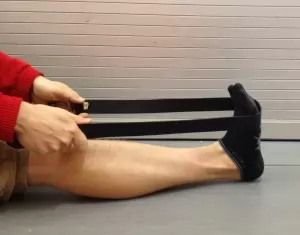
How to do it?
If your anterior tibialis muscle is weak, then you have difficulty flexing the foot. This means you have a shortened calf. A shortened
- the calf will be a tight muscle, so stretching the calf may be necessary to fully correct the foot drop.
- To perform this exercise you have to Wrap a towel around the ball of the foot, & the knee should be extended.
- Pull the ends of the towel so your foot flexes up & stretches your calf.
- Hold the stretch for 15-30 seconds.
- Relax. Perform this 3 times.
Seated Toe Raises
How to do it?
- For the Seated Toe Raises exercise, you have to Sit on a chair with the feet placed in front of you
- Now gradually raise your toes off of the ground.
- Hold for 2-5 seconds at the top
- Repeat for 2 -3 sets of 20-25 repetitions
Wall Toe Raises
How to do it?
- For the Wall Toe Raises exercise, you have to Stand 12-15 inches away with the back towards the wall with the feet hip-width
- apart.
- the knees might be slightly flexed then lean back into the wall.
- Elevate the toes off the floor & hold at the top for 2-4 seconds then lower the toes back to the floor.
- Repeat for 2-3 sets of 15-20 repetitions

How to do it?
- For the Heel Walk exercise, you have to stand on both feet hip-width apart with no shoes on.
- Elevate the toes off the floor so that your heels are in contact with the floor.
- Walk forward while leaning back and placing weight on the heels.
- Do this for 30-40 seconds.
- Repeat this 2 to 3 times.
When did you not do the Extensor hallucis longus strengthening exercise?
- If you feel any pain during this exercise then do not do this exercise.
- If you are already suffering from foot & ankle pain.
- If your doctor advised you to take rest.
- If the lower limb bones are recently fractured.
Health benefits of Extensor hallucis longus strengthening exercise:
- Assist to Reduce the risk of injury to the calf, foot, & ankle joints.
- Assist to reduce the chance of getting tibialis anterior tendonitis.
- Assist to increase ground clearance when walking to avoid tripping
- Reduce the risk of growing shin splints & stress fractures
- Speed up recovery of shin splints.
- Boost player performance in sports where the ankle is locked like in soccer to kick a ball
What are the safety & precautions of doing the Extensor hallucis longus exercise?
There are some safety measures you require to look for:
- Don does not bounce during the stretch. it causes injuries to the muscles. Such as strain.
- Never overstretch an Extensor hallucis longus muscle.
- Do not perform it so many times, it causes fatigue to the muscle. You might use a suggested time of repetition
- The holding time of the stretch should be recommended by your therapist which is normally 30-60 seconds.
- Never perform a stretch on the prior injured part of the body. Such as fractures, sprains, etc.
- Never stretch cold muscles, it causes pain. stretch it once you warm up the muscle.
FAQ
Lift your toes & front of your foot off the ground & pull them up towards the knee with the heel still touching the ground; Lift the toes & forefoot as high as possible & squeeze the muscles of the foot for a2 -the second count; and. Return to the starting position.
The extensor hallucis longus is stretched by flexing the big toe & plantarflexing & everting the foot. A wall and table can be used for balance.
The extensor hallucis longus especially extends the hallux dorsiflexes the foot at the ankle,& inverts the foot. The extensor hallucis longus muscle is susceptible to several pathologies, including nerve injury resulting in foot drop, tendonitis, tendon rupture, & anterior compartment syndrome.
Although extensor hallucis longus (EHL) strength has been identified as a primary predictor of L5 nerve root radiculopathy & deep peroneal nerve palsy, assessment of EHL strength is frequently overlooked.
Lateral toe stretch:
Sit on the feet flat on the ground
Point the toes up.
Move the toes to the left without moving the foot. Hold for five seconds.
Relax the toes.
Point the toes up.
Move the toes to the right without moving your foot.
Relax the toes.
Repeat the stretch with the toes pointed down.

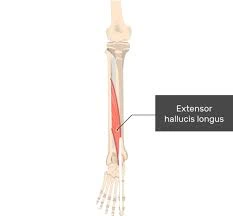
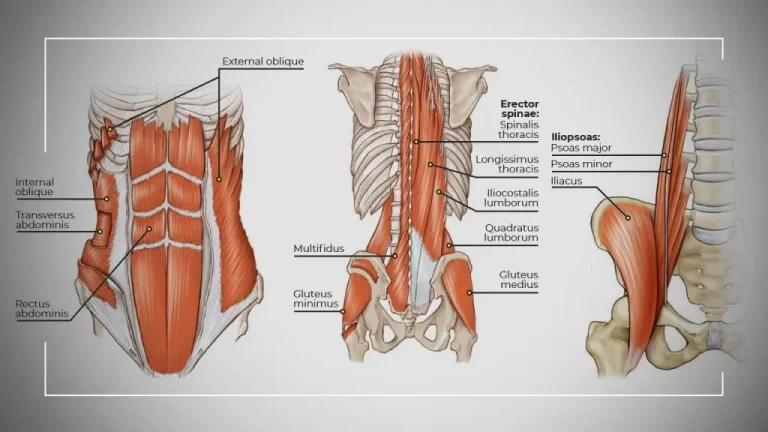

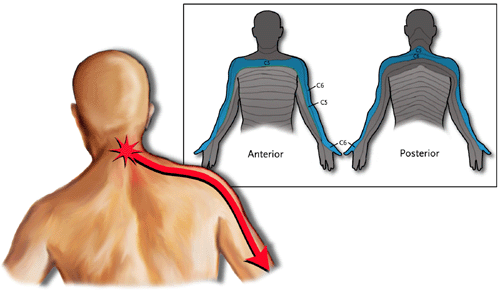
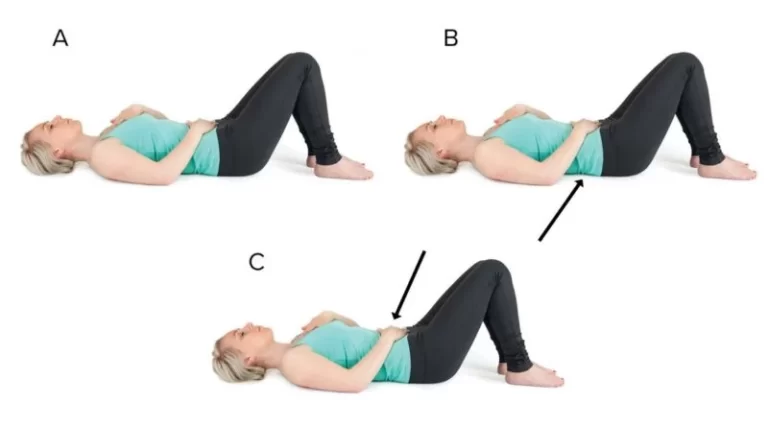

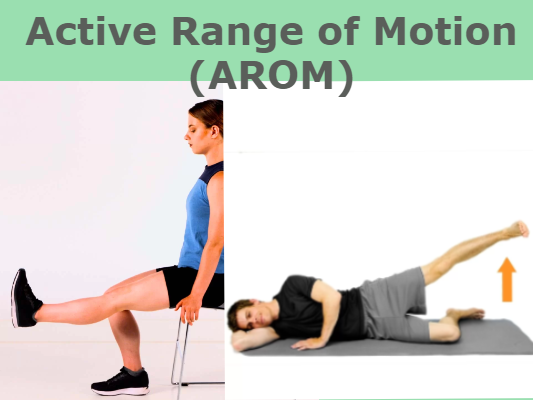
2 Comments